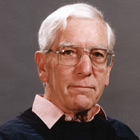
(b 13 March 1925, d 16 February 2014)
Born in Abercynon, South Wales, Bruce Godfrey Hyde's first glimpse of Australia was in 1945 from the deck of a British troop ship. Hyde spent about a year in the Fleet Air Arm of the British Navy in various parts of eastern Australia, an experience which sparked a lifelong love of the country.
After being discharged, Hyde enrolled at Bristol University, receiving a Bachelor of Science in 1951. In 1954, he returned to Australia to take up the first-ever postdoctoral position in the Chemistry Department at Melbourne University. Three years later, he took up a lectureship in chemistry at The University of Melbourne.
In 1960, Professor LeRoy Eyring from the State University of Iowa, and Professor Sten Andersson from the National Research Laboratories in Stockholm visited Melbourne; this was a time of great debate on the structural nature of so-called 'non-stoichiometric compounds', and it saw the germination of many fruitful ideas in Hyde's mind. He returned to Bristol, where he was awarded his PhD in1962, followed by a two year sojourn to the USA, where he worked as a Senior Research Fellow in the Chemistry Department of Arizona State University.
Hyde continued his travels in 1964, returning to Australia for a post as Senior Lecturer at The University of Western Australia, eventually becoming Reader. Here he did some of his most significant work, particularly on crystallographic shear in the higher titanium oxides, and an extended stay in the Watanabe Lab in Sendai led to a seminal paper on direct observation of extended defects in titanium oxides in 1969.
Hyde ventured to the Netherlands in 1975, where he held the position of Chair of Inorganic Chemistry at the University of Leiden. He spent multiple short periods as Visiting Fellow at Arizona State University and at Lund University, leading to collaboration on two valued publications on inorganic crystal structures. In 1977, he returned yet again to Australia, this time to a Personal Chair in Chemistry at the University of Western Australia. Finally, in 1979, he became Professor of Inorganic Chemistry at Australian National University, where he remained until retirement in 1990 and appointment as Emeritus Professor in 1991.
In 1975, Hyde was elected to the Academy, acting as a member of the Sectional Committee for chemistry from 1978–1981, serving as Chair from 1980–1981, and a member of the National Committee for Microscopy from 1980–1983. The 2005 election of his son, Dr Stephen Timothy Hyde, put Hyde in the proud position of one of the few Fellows whose children have also been elected to the Academy.
Hyde passed away on 16 February, 2014, remembered with great affection by his family, friends and colleagues.
© 2025 Australian Academy of Science